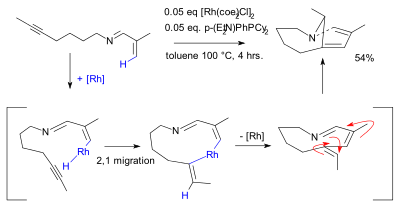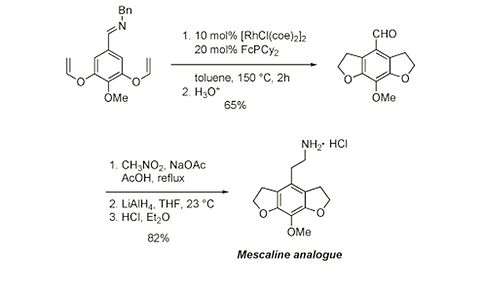Chlorobis(cyclooctene)rhodium dimer
Chlorobis(cyclooctene)rhodium dimer is an organorhodium compound with the formula Rh2Cl2(C8H14)4, where C8H14 is cis-cyclooctene. Sometimes abbreviated Rh2Cl2(coe)4, it is a red-brown, air-sensitive solid that is a precursor to many other organorhodium compounds and catalysts.
4corrected.png) | |
| Identifiers | |
|---|---|
3D model (JSmol) |
|
| ChemSpider | |
| ECHA InfoCard | 100.152.028 |
PubChem CID |
|
CompTox Dashboard (EPA) |
|
| |
| |
| Properties | |
| C32H56Cl2Rh2 | |
| Molar mass | 717.50 |
| Appearance | red-brown solid |
| Hazards | |
| GHS pictograms |  |
| GHS Signal word | Warning |
GHS hazard statements |
H302, H312, H315, H319, H332, H335 |
| P261, P264, P270, P271, P280, P301+312, P302+352, P304+312, P304+340, P305+351+338, P312, P321, P322, P330, P332+313, P337+313, P362, P363, P403+233, P405, P501 | |
Except where otherwise noted, data are given for materials in their standard state (at 25 °C [77 °F], 100 kPa). | |
| Infobox references | |
The complex is prepared by treating an alcohol solution of hydrated rhodium trichloride with cyclooctene at room temperature.[1] The coe ligands are easily displaced by other more basic ligands, more so than the diene ligands in the related complex cyclooctadiene rhodium chloride dimer.
Catalyst for C-H activation
C-H activation is often catalyzed by chlorobis(cyclooctene)rhodium dimer as demonstrated in the synthesis of a strained bicyclic enamine.[2]
 C–H bond activation Yotphan 2008
C–H bond activation Yotphan 2008
The synthesis of a mescaline analogue involves enantioselective annulation of an aryl imine via a C-H activation.[3]

The total synthesis of lithospermic acid employs "guided C-H functionalization" late stage to a highly functionalized system. The directing group, a chiral nonracemic imine, is capable of performing an intramolecular alkylation, which allows for the rhodium-catalyzed conversion of imine to the dihydrobenzofuran.[4]

References
- Van der Ent, A.; Onderdelinden, A. L. "Chlorobis(cyclooctene)rhodium(I) and di-μ-chlorobis[bis(cryclooctene)iridium] (I) complexes" Inorganic Syntheses 1973, volume 14, pp. 92-5. doi:10.1002/9780470132456.ch18
- Yotphan, Sirilata; Bergman, Robert G.; Ellman, Jonathan A. (2008). "The Stereoselective Formation of Bicyclic Enamines with Bridgehead Unsaturation via Tandem C–H Bond Activation/Alkenylation/ Electrocyclization". J. Am. Chem. Soc. 130 (8): 2452–2453. doi:10.1021/ja710981b. PMC 3062933. PMID 18247623.
- Ahrendt, Kateri A.; Bergman, Robert G.; Ellman, Jonathan A. (2003-04-01). "Synthesis of a Tricyclic Mescaline Analogue by Catalytic C−H Bond Activation". Organic Letters. 5 (8): 1301–1303. doi:10.1021/ol034228d. ISSN 1523-7060. PMID 12688744.
- O'Malley, S. J.; Tan, K. L.; Watzke, A.; Bergman, R. G.; Ellman, J. A. (2005). "Total Synthesis of (+)-Lithospermic Acid by Asymmetric Intramolecular Alkylation via Catalytic C-H Bond Activation". J. Am. Chem. Soc. 127 (39): 13496–13497. doi:10.1021/ja052680h. PMID 16190703.